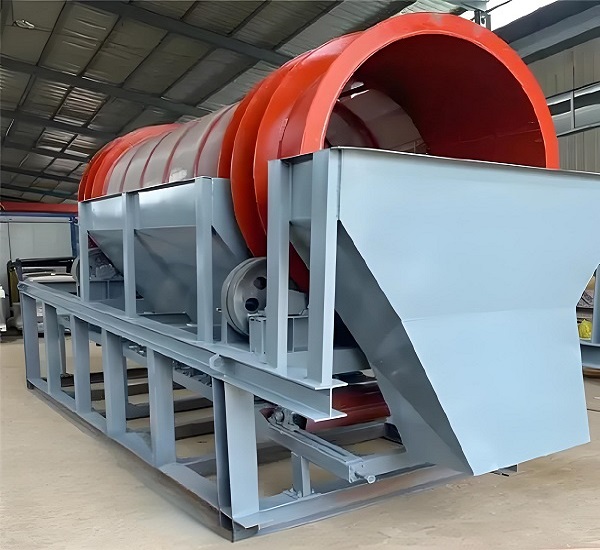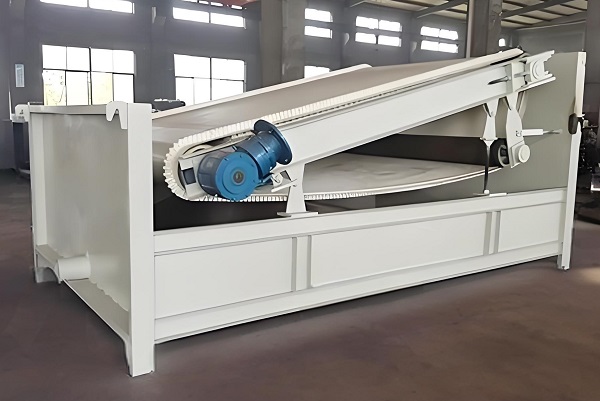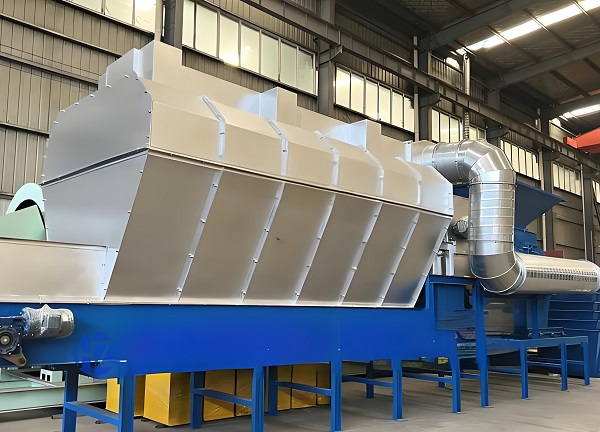Preface: In today's era of environmental protection and resource recycling, the garbage sorting machine in the garbage disposal process shoulders a vital mission. It is like a rigorous "classification master", which can accurately classify and screen the mixed garbage with complex components according to different materials and characteristics, laying a solid foundation for the subsequent resource utilization and harmless treatment of garbage. Next, let's explore how the garbage sorting machine works.
A. Working principle of garbage sorting machine

Trommel Screen
The magic of the garbage sorting machine lies in its clever use of the differences in physical properties of different garbage, such as density, shape, size, magnetism and conductivity, etc., and the use of a variety of technical means to achieve efficient classification of garbage.
1. Sorting based on density difference
Under the joint action of gravity and aerodynamic principles, garbage will naturally stratify or separate due to different densities during movement. Take the air separator as an example. When the garbage is transported to the inside of the air duct, the fan runs at full speed to generate strong wind. At this time, light garbage such as paper and plastic film are like light feathers, easily blown away by the wind; while heavy garbage such as metal and stone can only fall at a closer position due to their own gravity. In this way, the wind separator easily achieves the initial separation of light and heavy garbage, laying the foundation for subsequent fine sorting.
2. Sorting based on shape and size
Screens, drums and other components of different shapes and sizes have become a powerful assistant for garbage sorting. Among them, the drum screen is a common and practical sorting equipment. When the garbage enters the rotating drum, it is like entering a wonderful "screening maze". Smaller garbage can pass through the sieve holes on the drum smoothly and fall down happily like naughty elves; while larger garbage is left in the drum and slowly discharged along a specific path, thus easily achieving the purpose of sorting garbage by size.
3. Sorting with the help of magnetism and conductivity
For garbage containing metal, the magnetic separator plays a key role. The magnetic separator can generate a strong magnetic field inside, like a "super magnet" with strong suction. When the garbage passes through the magnetic field area, ferromagnetic metals such as iron, cobalt, and nickel are instantly firmly attracted by the magnet of the magnetic separator. As the magnet rotates, these metals are brought to the designated position. Once they are out of the magnetic field, they fall down one after another and are successfully separated from other garbage. For garbage with different conductivity, electrostatic sorting technology is very useful. By allowing garbage particles to carry different charges in a high-voltage electric field, and then based on the interaction between charges and the action of the electric field force, garbage with different conductivity can be accurately separated.
B. Core components and work flow of garbage sorting machine

Magnetic Separator
1. Feeding system
As the starting step of garbage sorting, the importance of the feeding system is self-evident. It is like a conscientious "porter" who is responsible for evenly and stably transporting mixed garbage to subsequent sorting equipment. Common feeding equipment includes belt conveyors and vibrating feeders. The belt conveyor relies on the motor to drive the belt to rotate smoothly and transport the garbage steadily. Its conveying speed and conveying volume can be flexibly adjusted according to actual needs; the vibrating feeder uses the high-frequency vibration generated by the vibrating motor to make the garbage jump forward happily in the feeding trough, which not only achieves uniform feeding, but also cleverly avoids the problem of garbage accumulation.
2. Screening and separation components
Screening equipment: The drum screen mentioned above is an important part of the garbage sorting machine. In addition to it, the vibrating screen also plays an important role in the sorting work. The high-frequency vibration generated by the vibrating screen through the eccentric block allows the garbage to jump quickly on the screen surface, like a group of active dancers. This rapid jumping greatly accelerates the speed at which small particles of garbage pass through the sieve holes, effectively improving the screening efficiency. Moreover, the screens with different sieve hole sizes can be replaced at any time according to actual needs to meet the screening requirements of different types of garbage.
Gravity sorting equipment: The jig is a typical gravity sorting equipment. Inside the jig, the water flow pulsates up and down rhythmically, like a regular dance. Under the action of this water flow, the garbage is naturally layered according to different densities. Garbage with high density sinks to the lower layer like a steady "diver", while garbage with low density floats to the upper layer like a light "balloon", and then is discharged from different outlets, successfully achieving the precise separation of garbage with different densities.
Magnetic separation equipment: In addition to ordinary magnetic separators, hanging magnetic separators also play a unique role in garbage sorting. It is usually installed above the belt conveyor, like a "guardian" on standby at all times. When the garbage is slowly conveyed on the belt conveyor, the hanging magnetic separator can quickly capture and adsorb the magnetic metals in the garbage, and the whole process is convenient and fast.

Wind Sifter
3. Subsequent processing and collection system
After sorting, various types of garbage usher in their subsequent "journey". For recyclables such as paper, plastic, and metal, they will be transported to a special recycling and processing area for further processing and recycling to achieve resource recycling; non-recyclable organic garbage may be sent to the composting workshop and converted into organic fertilizer under the action of microorganisms; and hazardous garbage will be carefully collected and transported to a special treatment site for harmless treatment to ensure environmental safety. The collection system generally uses different conveying pipes, containers, etc., like precise "transportation tracks" to ensure that all types of garbage can be accurately transported to the corresponding processing links.
PS: The garbage sorting machine successfully classifies mixed garbage through the coordinated operation of multiple scientific principles and a series of complex equipment, opening up a broad road for the subsequent treatment and resource recycling of garbage. With the continuous advancement of science and technology, the performance and sorting efficiency of garbage sorting machines are also continuously improving. I believe that in the future, it will play a more important role in the field of garbage disposal and inject strong impetus into the environmental protection cause.
Save Time! Get A Detailed Quotation Quickly.
